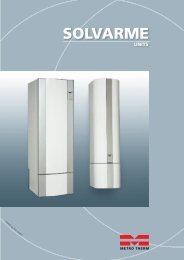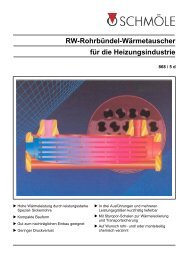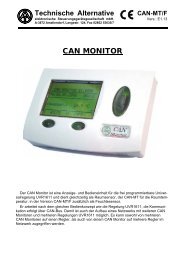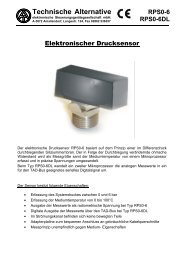Technische Alternative - Varmt vand fra solen
Technische Alternative - Varmt vand fra solen
Technische Alternative - Varmt vand fra solen
You also want an ePaper? Increase the reach of your titles
YUMPU automatically turns print PDFs into web optimized ePapers that Google loves.
Stability problems<br />
The speed control has a PID controller. It ensures an exact and fast adjustment of the actual<br />
value to the set point. In applications such as solar power systems or feed pumps, the<br />
following parameters should be left in factory settings. With a few exceptions, the system will<br />
run stably. These two values have to be balanced, however, especially for hygienic hot water<br />
from the external heat exchanger. In addition, in this case the use of an ultrafast sensor (nonstandard<br />
accessory) is recommended at the hot water outlet.<br />
Set value = desired value Actual value = temperature measured<br />
PRO 5 Proportional part of the PID controller 5. It represents the reinforcement of the<br />
deviation between the desired and the actual value. The speed is changed by one<br />
increment for each 0.5K of deviation from the desired value. A large number leads<br />
to a more stable system but also to more deviation from the predefined temperature.<br />
(ex works = 5) Setting range: 0 to 9<br />
INT 5 Integral part of the PID controller 5. It periodically adjusts the speed relative to the<br />
deviation remaining from the proportional part. For each 1K of deviation from the<br />
desired value, the speed changes one increment every 5 seconds. A large number<br />
provides a more stable system, but it then takes longer to reach the desired<br />
value. (ex works = 0) Setting range: 0 to 9<br />
DIF 5 Differential part of the PID controller 5. The faster a deviation occurs between the<br />
desired and the current value, the greater the short-term overreaction will be to<br />
provide the fastest compensation possible. If the desired value deviates at a rate<br />
of 0.5K per second, the speed is changed by one increment. Large numbers provide<br />
a more stable system, but it then takes longer to reach the desired value. (ex<br />
works = 0) Setting range: 0 to 9<br />
The parameters PRO, INT, and DIF can also be determined in a test: Assume that the<br />
pump is running in automatic mode in a unit that is ready for operation with appropriate temperatures.<br />
With INT and DIF set to zero (= switched off), PRO is reduced every 30 seconds<br />
starting at 10 until the system is instable. In other words, the pump speed changes rhythmically<br />
and can be read in the menu with the command ACT. Every proportional part that becomes<br />
instable is noted as Pkrit just as the duration of the oscillation (= time between the two<br />
highest speeds) is noted as tkrit. The following formulas can be used to determine the correct<br />
parameters.<br />
A typical result of hygienic service water with the ultrafast sensor is PRO = 8, INT = 9, DIF<br />
= 3. For reasons not entirely understood, the setting PRO = 3, INT = 1, DIF = 4 has proven<br />
practical. Probably, the control unit is so unstable that it oscillates very quickly and appears to<br />
be balanced due to the system’s and the fluid’s inertia.<br />
27








